
Passiflora, known also as the passion flowers or passion vines, is a genus of about 550 species of flowering plants, the type genus of the family Passifloraceae.
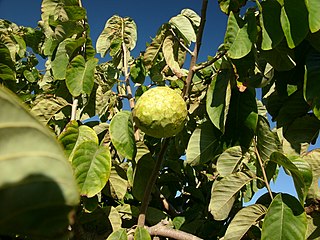
The cherimoya, also spelled chirimoya and called chirimuya by the Inca people, is a species of edible fruit-bearing plant in the genus Annona, from the family Annonaceae, which includes the closely related sweetsop and soursop. The plant has long been believed to be native to Ecuador and Peru, with cultivation practised in the Andes and Central America, although a recent hypothesis postulates Central America as the origin instead, because many of the plant's wild relatives occur in this area.

Carissa is a genus of shrubs or small trees native to tropical and subtropical regions of Africa, Australia and Asia. Until recently about 100 species were listed, but most of them have been relegated to the status of synonyms or assigned to other genera, such as Acokanthera.

Cornus canadensis is a species of flowering plant in the dogwood family Cornaceae, native to eastern Asia and North America. Common names include Canadian dwarf cornel, Canadian bunchberry, quatre-temps, crackerberry, and creeping dogwood. Unlike its relatives, which are for the most part substantial trees and shrubs, C. canadensis is a creeping, rhizomatous perennial growing to about 20 centimetres tall.
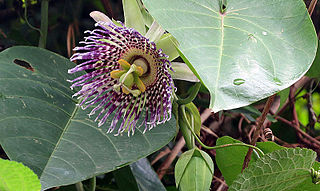
Passiflora ligularis, commonly known as the sweet granadilla or grenadia, is a plant species in the genus Passiflora. It is known as granadilla in Bolivia, Colombia, Nicaragua, Costa Rica, Ecuador, Mexico, The Azores, South Africa and Peru; granadilla común in Guatemala; granadilla de China or parcha dulce in Venezuela and granaditta in Jamaica.
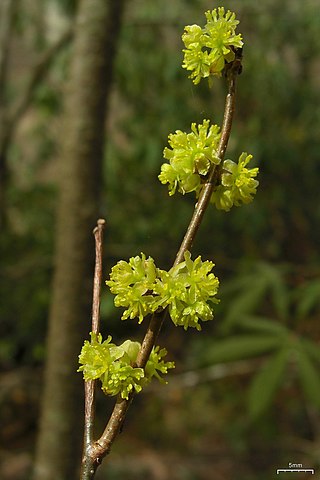
Lindera benzoin is a shrub in the laurel family. It is native to eastern North America, ranging from Maine and New York to Ontario in the north, and to Kansas, Texas, and northern Florida in the center and south. Within its native range it is a relatively common plant where it grows in the understory in moist, rich woods, especially those with exposed limestone.

Chrysobalanus icaco, the cocoplum, paradise plum, abajeru or icaco, also called fat pork in Trinidad and Tobago, is a low shrub or bushy tree found near sea beaches and inland throughout tropical Africa, tropical Americas and the Caribbean, and in southern Florida and the Bahamas. An evergreen, it is also found as an exotic species on other tropical islands, where it has become a problematic invasive. Although taxonomists disagree on whether Chrysobalanus icaco has multiple subspecies or varieties, it is recognized as having two ecotypes, described as an inland, much less salt-tolerant, and more upright C. icaco var. pellocarpus and a coastal C. icaco var. icaco. Both the ripe fruit of C. icaco, and the seed inside the ridged shell it contains, are considered edible.
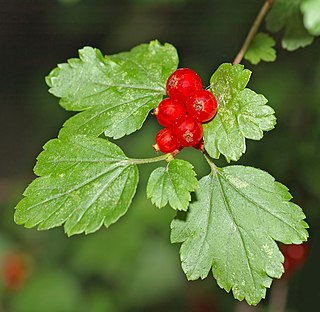
Ribes alpinum, known as mountain currant or alpine currant, is a small deciduous, dioecious shrub native to central and northern Europe from Finland and Norway south to the Alps and Pyrenees and Caucasus, Georgia; in the south of its range, it is confined to high altitudes. It is scarce in western Europe, in Britain being confined to a small number of sites in northern England and Wales.

Castanea pumila, commonly known as the Allegheny chinquapin, American chinquapin or dwarf chestnut, is a species of chestnut native to the southeastern United States. The native range is from Massachusetts and New York to Maryland and extreme southern New Jersey and southeast Pennsylvania south to central Florida, west to eastern Texas, and north to southern Missouri and Kentucky. The plant's habitat is dry sandy and rocky uplands and ridges mixed with oak and hickory to 1000 m elevation. It grows best on well-drained soils in full sun or partial shade.
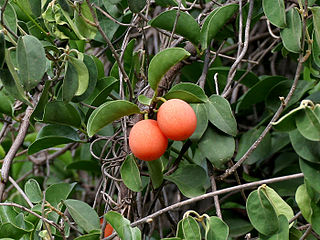
Ximenia americana, commonly known as tallow wood, hog plum, yellow plum, sea lemon, or pi'ut (Chamorro), is bush-forming shrub/small tree; a species from the Ximenia genus in the Olacaceae family. It is mainly found in the tropics, ranging from Africa, India and southeast Asia, to Australia, New Zealand, Pacific Islands, West Indies, Central, North and South America. It is especially common in Africa and South America. It is not domesticated so it is only found occurring in the wild.

Coprosma quadrifida is a dioecious shrub of the family Rubiaceae native to southeastern Australia. First described as Canthium quadrifidum by Labillardiere, it was given its current name by B. L. Robinson in 1910. Typically found at damp sites within woodlands, Eucalyptus forests or cool-temperate rainforests, it prefers sheltered slopes or sites near water sources. They are able to withstand frost and are salt tolerant. The species is also known as the Prickly Currant Bush.
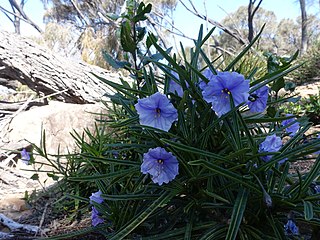
Solanum vescum, commonly known as green kangaroo apple or gunyang, is a small fruiting shrub in the family Solanaceae, native to eastern and southeastern Australia.

Capsicum chacoense is a species of the genus Capsicum native to South America. While it is rarely cultivated by humans, it, like domesticated Capsicum species, produces edible fruit.

Persoonia falcata, commonly known as the wild pear, is a shrub native to northern Australia.

Ceanothus herbaceus, also known as Jersey tea, is a species of shrub in the family Rhamnaceae and is similar to Ceanothus americanus and Ceanothus sanguineus. It is a perennial shrub which is native to North America.

Rubus tricolor is an evergreen prostrate shrub, native to southwestern China. Leaves are dark green above, pale green below, and stems have red bristles. It has white flowers in summer and edible red fruit. It grows approximately 0.3 m (0.98 ft) high and usually forming a vigorously spreading, dense mat. In cultivation, it is mainly used as groundcover. Common names include Chinese bramble, groundcover bramble, creeping bramble, Korean raspberry, Himalayan bramble, and groundcover raspberry. In Chinese, it is called 三色莓.

Alternanthera brasiliana, also known as large purple alternanthera, metal weed, bloodleaf, parrot leaf, ruby leaf, Brazilian joyweed, purple alternanthera, purple joyweed, is a flowering plant of the amaranth family that is native to the forests of South America and as well as Central America, ranging from northeastern Mexico to northeastern Argentina. It is grown as an ornamental plant.

Cola greenwayi, commonly known as hairy cola or Zulu coshwood, is a species of flowering plant in the family Malvaceae. It was first described in 1956 by the British botanist John Patrick Micklethwait Brenan. It is native to southeastern Africa.

Drypetes gerrardii is a species of small tree or large shrub in the family Putranjivaceae. Common names include forest ironplum, bastard white ironwood, and forest ironwood. It is native to tropical and subtropical central and eastern Africa. It was first described in 1920 by the English botanist John Hutchinson, who named it after the English botanist William Tyrer Gerrard who collected plants and seeds in southern Africa in the 1860s.
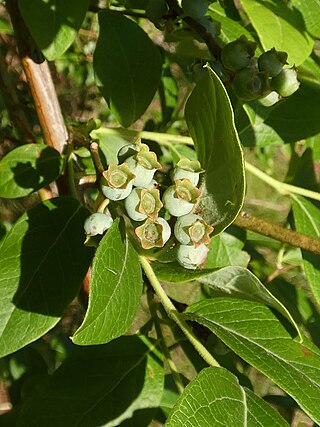
Vaccinium formosum, with common names highbush blueberry, southern blueberry, southern highbush blueberry, and swamp highbush blueberry, is a species of blueberry that is native to the Southeastern United States.



















